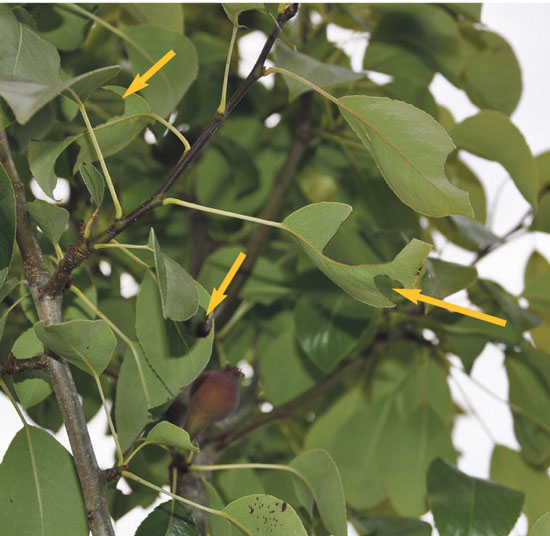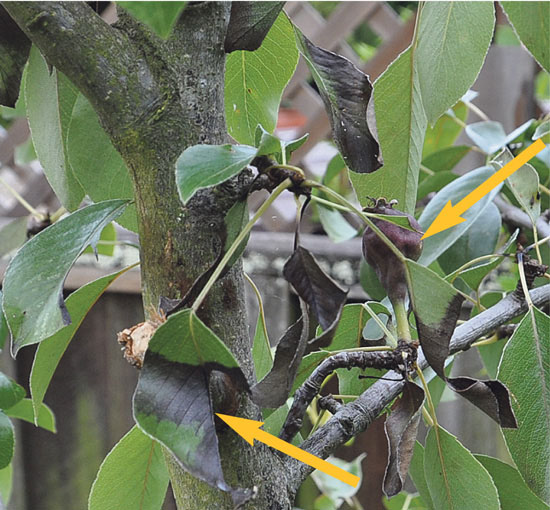 | | | Arrows point to the telltale holes in the leaves that are indicative
of the early stages of fire blight Photo Andy Scheck
| | | | | | Every spring, Moraga's blooming pear orchards offer a feast for the eyes. This year we even received a phone call from a Lafayette resident who wanted to know where, and when, to go for prime pear tree viewing. My own pear tree bore a grand floral display, and the hard-working bees did their job pollinating them on our few dry days.
 Late last week I noticed that my tree sported some dried twigs and I started to wonder what was going on. Looking closer, I discovered that the tree showed symptoms of fire blight disease. I was first introduced to fire blight in Germany, where it's very common. Seeking a second opinion on my diagnosis, I clipped twigs and leaves off the tree and brought them to the Moraga Garden Center. The owner, Kenny Murakami, confirmed my theory and encouraged me to act quickly.
Late last week I noticed that my tree sported some dried twigs and I started to wonder what was going on. Looking closer, I discovered that the tree showed symptoms of fire blight disease. I was first introduced to fire blight in Germany, where it's very common. Seeking a second opinion on my diagnosis, I clipped twigs and leaves off the tree and brought them to the Moraga Garden Center. The owner, Kenny Murakami, confirmed my theory and encouraged me to act quickly.
 Fire blight is caused by bacteria (erwinia amylovora) and is common on roses, as well as pear and apple trees. It generally starts from the blossom or flower and moves up the twigs into the branches. It's often fatal for the plant. The bacteria spread easily by several methods, such as rain, birds, insects, or when plants brush against each other.
Fire blight is caused by bacteria (erwinia amylovora) and is common on roses, as well as pear and apple trees. It generally starts from the blossom or flower and moves up the twigs into the branches. It's often fatal for the plant. The bacteria spread easily by several methods, such as rain, birds, insects, or when plants brush against each other.
 The best way to deal with this disease is to remove all of the infected parts of the plant. Branches should be cut at least eight inches from the infected area. All infected material should be burned or discarded in the trash. Make sure you don't leave any material on the ground as it can spread from there to other plants or back to the treated plant.
The best way to deal with this disease is to remove all of the infected parts of the plant. Branches should be cut at least eight inches from the infected area. All infected material should be burned or discarded in the trash. Make sure you don't leave any material on the ground as it can spread from there to other plants or back to the treated plant.
 It is also recommended to sterilize the clippers after every clip you make. Dip the tool into an alcohol solution or a mixture of household bleach and water (one part bleach to nine parts water) after every clip; wash and dry the clippers when you're done to prevent corrosion.
It is also recommended to sterilize the clippers after every clip you make. Dip the tool into an alcohol solution or a mixture of household bleach and water (one part bleach to nine parts water) after every clip; wash and dry the clippers when you're done to prevent corrosion.
 Catching and treating fire blight early will minimize the disease's impact on your plant. If you have to clip many twigs and branches to fight the blight, you might end up with a wiry tree or plant and opt to remove the whole thing. So time is of the essence, for all of us who love our gardens, as fire blight spreads very quickly.
Catching and treating fire blight early will minimize the disease's impact on your plant. If you have to clip many twigs and branches to fight the blight, you might end up with a wiry tree or plant and opt to remove the whole thing. So time is of the essence, for all of us who love our gardens, as fire blight spreads very quickly.
 It is always helpful to check with your local garden or landscape center for advice. For more information on fire blight, go to www.fireblight.com.
It is always helpful to check with your local garden or landscape center for advice. For more information on fire blight, go to www.fireblight.com.

|

